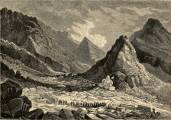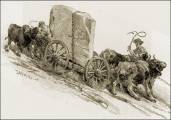


The Connecticut Stone Industry, 1908
Excerpts from
Mineral Resources of the United States, Calendar Year
1908
Part II - Nonmetallic Products
Department of the Interior, United States Geological
Survey
Government Printing Office, Washington, D. C., 1909.
Excerpts from the book are from the chapters on: 1) Stone, by a. T. Coons; and 2) part of chapter on Abrasive Materials, by W. C. Phalen.
Building Stone Distribution: Distribution of the various kinds of building stone and the localities where the different varieties of stone are now being quarried or may be quarried in the future for Connecticut are Soapstone, serpentine (verdantique marble), marble, granite and gneiss, diabase, sandstone.
Granite: The figures given in this report as representing the value of the granite production in the United States include also the values of small quantities of gneiss, mica schist, lava, tuff, trachyte, andesite, syenite, quartz porphyry, trap, basalt, and allied igneous rocks. The quantities of these allied rocks quarried are too small to tabulate separately. Trap rock in the States of California, Connecticut, Massachusetts, New Jersey, New York, and Pennsylvania, however, represents an industry sufficient by itself to make it advisable to tabulate this stone separately, and its value is not included in the grand total of granite.
In 1907 the rank in output of States producing granite to the value of $500,000 or more was Vermont, Massachusetts, Maine, California, Wisconsin, Maryland, North Carolina, Georgia, Rhode Island, New Hampshire, Connecticut, Washington, and Minnesota; in 1908, Vermont, Maine, Massachusetts, California, Wisconsin, Georgia, Washington, New Hampshire, North Carolina, Maryland, Minnesota, Connecticut and Rhode Island decreased in value of production.
Riprap: Granite sold for riprap increased in value from $620,033 in 1907 to $1,232,684 in 1908, a gain of $612,651. Washington, California, Connecticut, South Carolina, and Texas showed the largest output of this stone, which was used in riprap and in construction of breakwaters and jetty work in various rivers and harbors.
Trap rock: New Jersey had the largest output of trap rock in 1908, followed by California, New York, Pennsylvania, Massachusetts, and Connecticut in the order named. In 1907 California, on account of large demand for crushed stone to repair roads damaged by the earthquake of 1906, took first rank, followed by New Jersey, New York, Pennsylvania, Connecticut, and Massachusetts.
Onyx marble: The onyx marble of the United States, except perhaps that of California and Arizona, is not considered as good as the Mexican article in color or in fineness of texture and is more expensive for the reason that labor is cheaper in Mexico and that in Mexico the quarries have been opened long enough to have transportation facilities. In most cases in the United States the onyx is found in territory which is but little developed and in which both labor and transportation are high, and the deposits are owned by firms and individuals who have not the means necessary to develop them. The principal deposits in the United States are in Arizona, Arkansas, California, Colorado, Idaho, Connecticut, Missouri, Montana, New Mexico, South Dakota, Utah, Virginia, Tennessee, Texas, and Washington; cave onyxes, however, are found in nearly all of the large limestone-producing States.
Excerpts from Bibliography:
Ries, H. The limestone quarries of eastern New York, western Vermont, Massachusetts, and Connecticut. In Seventeenth Ann. Rept., pt. 3 (continued), pp. 795-811. 1896.
Abrasives in Connecticut: Infusorial earth, quartz, and feldspar.
Commercial use of material within this site is strictly prohibited. It is not to be captured, reworked, and placed inside another web site ©. All rights reserved. Peggy B. and George (Pat) Perazzo.